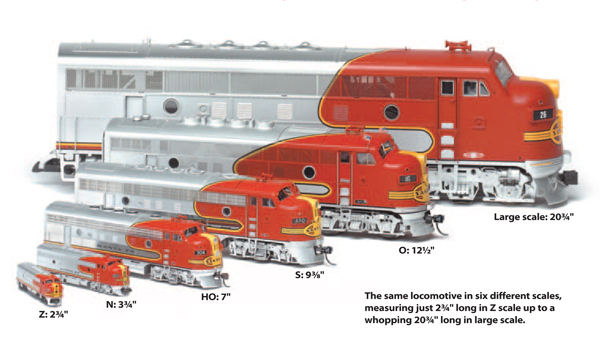where do you find a 1218 model train
Learn the nuts about the most mutual modeling scales used by model railroaders

You don't have to spend much fourth dimension with model trains to realize that they come up in a number of dissimilar sizes. These differences are i of the things that make model trains so much fun because there are advantages to each size. Allow's take a look at them and so you can call back about which size may be best for you.
Model and toy trains are classified according to scale and gauge. "Calibration" describes the size of a miniature in proportion to its full-size paradigm. "Gauge" refers to the distance between the rails of the rail.
From the largest
The largest model trains are collectively referred to as "big scale" trains. These big trains often operate outdoors on what are called garden railroads, though of grade they can be run indoors, equally well.
These models are offered in a range of proportions, including 1:32, ane:22.five (chosen "1000 scale"), and 1:20. Simply all of them operate on Gauge i rails, which measures 45mm between the rail.
The next largest pop scale is O (1:48 proportion; pronounced "oh"). Track in O guess measures 1¼" betwixt the rails. This estimate is used for both toy (non-calibration) and model trains. Lionel's O scale trains have been produced for almost 100 years and, at their peak in the 1940s and '50s, helped introduce millions of children to their lifelong hobby.
Slightly smaller than O scale is S scale (1:64 proportion). These locomotives and cars, originally popularized past American Flyer, run on track spaced 7/eight″ apart. Unlike their toy predecessors, today'due south S scale models are as highly detailed as trains in other scales.
To the smallest
Overshadowing the larger scales in popularity are models built to exist approximately one-half the size of O calibration models (that'south why they are called "HO" – pronounced "aitch-oh"). These trains are 1/87 the size of their existent-world prototypes, and HO gauge track measures 16.5mm between the rail. HO trains are modest plenty to allow a satisfying layout in a meaty infinite, say a iv x viii-foot sheet of plywood, while still existence large enough to show great particular. No wonder HO railroading is the most popular of the scales, with more than than two-thirds of modelers making it their pick.
Smaller all the same is Northward calibration. Rolling stock and locomotives of this size are ane/160 the size of their existent-life counterparts. The track gauge is 9mm between the rails. N calibration works well for modelers who don't have a lot of space or who adopt to run trains through truly expansive scenery.
Even smaller are Z scale trains. Their proportion to the real thing is ane:220, and they run on runway whose rails are just 6.5mm apart. How tiny are these trains? Well, a model of a real-life l-foot locomotive measures just 23⁄iv″ in Z.
Which size is best?
No one scale is right for everyone. Look at several scales and consider how much space you have to devote to your trains, whether you want to run longer trains amid towering scenery, and how much you lot can spend on your hobby.
Talk with experienced modelers, club members, and local hobby shop employees. Don't worry if you change your mind and later make up one's mind that a different model railroading calibration is a better choice for you. They're all great.
Source: https://www.trains.com/mrr/videos-photos/videos/beginners/your-guide-to-scales-and-gauges/
Posted by: mckinneychithin.blogspot.com

0 Response to "where do you find a 1218 model train"
Post a Comment